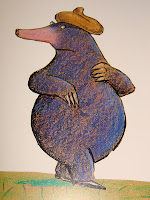 We could not have had a better introduction to this unit than by the 5th/6th Graders of Mr. B's Class. They all gave presentations regarding various areas of the human body (including the digestive track) complete with visual aids. Using a team approach, they exhibited such poise and ownership of their own material. The 5th/6th Graders were articulate, confident, witty, and appropriate. They even filtered impromptu questions by the Kindergartners with relevant and accurate answers. They knew their material and appeared proud to share their knowledge with us! We were a receptive and appreciative audience for them, I hope.
We could not have had a better introduction to this unit than by the 5th/6th Graders of Mr. B's Class. They all gave presentations regarding various areas of the human body (including the digestive track) complete with visual aids. Using a team approach, they exhibited such poise and ownership of their own material. The 5th/6th Graders were articulate, confident, witty, and appropriate. They even filtered impromptu questions by the Kindergartners with relevant and accurate answers. They knew their material and appeared proud to share their knowledge with us! We were a receptive and appreciative audience for them, I hope.
Before our own "Human Body" unit began, I polled the Kindergartners about what kinds of topics they were interested in learning more about concerning the human body. These were some of their answers:
"The Ribs!"-Olivia
"The Muscles!"-Folu
"The Ears!"-Kai
"The Brain!"-Eleanor
"The Blood!"-Maia & Alex
"The Mouth!"-Mason
"The Arms!"-Lilith
"The Tummy-Niccolo!"
"Pee and Poop!"-Ava So here goes.
Last week's K Buddies included a Magic School Bus video about the Human Body. It discussed the various functions of the human body and compared it to a robot. It discussed among other topics, the joints, the blood, and the digestive tract. It also addressed commonly asked questions about the accuracy of the depicted video content.
 This week Kindergartners listened to The Story of the Little Mole Who Went in Search of Whodunit by Werner Holzwarth and Wolf Erlbruch. The children predicted that the mass on top of the Mole's head on the book cover was "cheese." We talked about some of the un-usual "suspects" and the clues they left behind. We later found out this "whodunit", or mystery, was indeed about the wonderful world of elimination or more specifically, animal droppings. We later went on a search in the woods and found one in particular that may have been a dog's whodunit. Other discoveries, rain puddles for example, were thought to be animal urine.
This week Kindergartners listened to The Story of the Little Mole Who Went in Search of Whodunit by Werner Holzwarth and Wolf Erlbruch. The children predicted that the mass on top of the Mole's head on the book cover was "cheese." We talked about some of the un-usual "suspects" and the clues they left behind. We later found out this "whodunit", or mystery, was indeed about the wonderful world of elimination or more specifically, animal droppings. We later went on a search in the woods and found one in particular that may have been a dog's whodunit. Other discoveries, rain puddles for example, were thought to be animal urine. We discussed the importance of the kidneys in the elimination process and how it is used to filter waste out of the blood.
We discussed the importance of the kidneys in the elimination process and how it is used to filter waste out of the blood. We also had a discussion about my sister who donated a kidney to my cousin because my cousin's kidney stopped functioning. I needed to explain that everyone has two kidneys, so one could actually spare a healthy one. (The children were concerned that my sister no longer had one of her own.) One child also recalled someone getting rid of some organ they did not need and now they do not have one-(the appendix I'm assuming). We also discussed the need for dialysis, antibiotics, the job of a donor, and what it means to be a "perfect match." We later discussed why women were a better candidate for having babies. I gave them that discussion for homework/:) In the afternoon, we read Everyone Poops by Taro Gomi and talked further about one of the body's many necessary functions to stay healthy and alive.

No comments:
Post a Comment